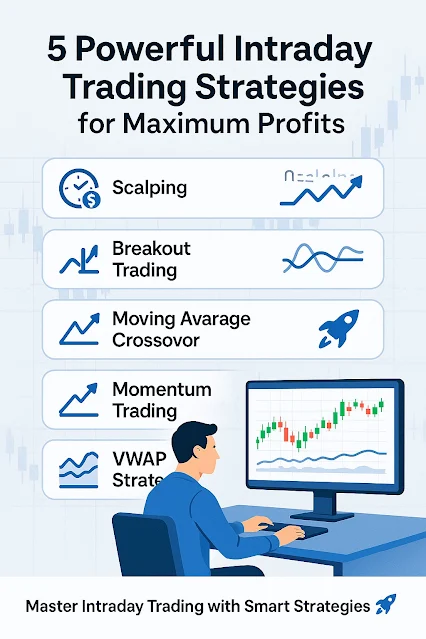Table of Contents
 |
| Master intraday trading with effective strategies like Scalping, Breakout Trading, and Momentum Trading to maximize profits and manage risks |
1. Scalping: Capitalizing on Small Price Movements
Scalping is a popular strategy in intraday trading where traders aim to profit from small price changes within a very short period. Scalpers usually hold their positions for just minutes, making multiple trades in a single day. The idea is to take advantage of minor price fluctuations by executing fast entries and exits.
How to Implement:
- Use Short Timeframes: The best charts for scalping are 1-minute or 5-minute charts.
- Use Indicators: The Relative Strength Index (RSI) and Moving Average Convergence Divergence (MACD) can help identify entry and exit points.
- Risk Management: Since the profit per trade is small, use tight stop-losses to minimize losses.
Learn more about Risk Management in Intraday Trading .
2. Breakout Trading: Entering at Key Levels
Breakout trading capitalizes on price movements that occur when the price breaks through established support or resistance levels. This strategy works best in volatile markets, where prices tend to move significantly once they breach key price levels.
Steps for Breakout Trading:
- Identify Key Levels: Use chart analysis to find strong support and resistance levels.
- Wait for the Breakout: Enter your trade when the price breaks out of these levels.
- Confirm with Volume: A successful breakout is usually accompanied by increased trading volume, which adds confirmation to the price movement.
Read more about breakout strategies on Investopedia.
3. Moving Average Crossover: Spotting Trend Reversals
This strategy involves using two moving averages: one short-term and one long-term. A "crossover" occurs when the short-term moving average crosses above the long-term moving average (bullish signal) or vice versa (bearish signal). This is a widely-used strategy to spot trend reversals in intraday trading.
How to Apply:
- Select Moving Averages: Common choices are the 5-period Simple Moving Average (SMA) and the 20-period SMA.
- Watch for Crossovers: Buy when the short-term SMA crosses above the long-term SMA, and sell when the opposite happens.
- Confirm with Volume: Ensure that the crossover is supported by higher-than-average volume.
4. Momentum Trading: Riding the Trend
Momentum trading focuses on identifying stocks or assets that are experiencing significant price movement. Traders use momentum indicators to ride the wave of the trend, entering positions when they expect the price to continue in the same direction.
Steps for Momentum Trading:
- Spot Momentum Stocks: Use scanners or filters to find stocks with strong price momentum.
- Enter on Pullbacks: Wait for minor price pullbacks during an uptrend or downtrend to enter your trade.
- Set Targets: Use stop-loss orders and target prices to manage risk and lock in profits.
5. VWAP Strategy: Volume-Weighted Average Price
The Volume-Weighted Average Price (VWAP) strategy is a widely-used method to determine the trend direction. Traders buy when the price is above the VWAP and sell when it's below, using the VWAP as a dynamic support or resistance level.
How to Use VWAP:
- Plot VWAP on Your Chart: Many platforms offer VWAP as a built-in indicator.
- Follow the Trend: If the price is above the VWAP, it suggests an uptrend, and if it's below, it indicates a downtrend.
- Volume Confirmation: Like other strategies, make sure the trend is supported by high trading volume.
Conclusion: Mastering Intraday Trading Strategies
Each of the strategies above has its strengths and can be highly effective if used properly. Scalping is excellent for quick profits, while breakout and momentum trading can provide substantial gains during market swings. The Moving Average Crossover is ideal for identifying long-term trends, and the VWAP strategy helps traders track the market's true direction.
Make sure to practice sound risk management and tailor these strategies to fit your personal trading style.
For more tips on improving your trading skills, visit TradingView's blog.

Post a Comment